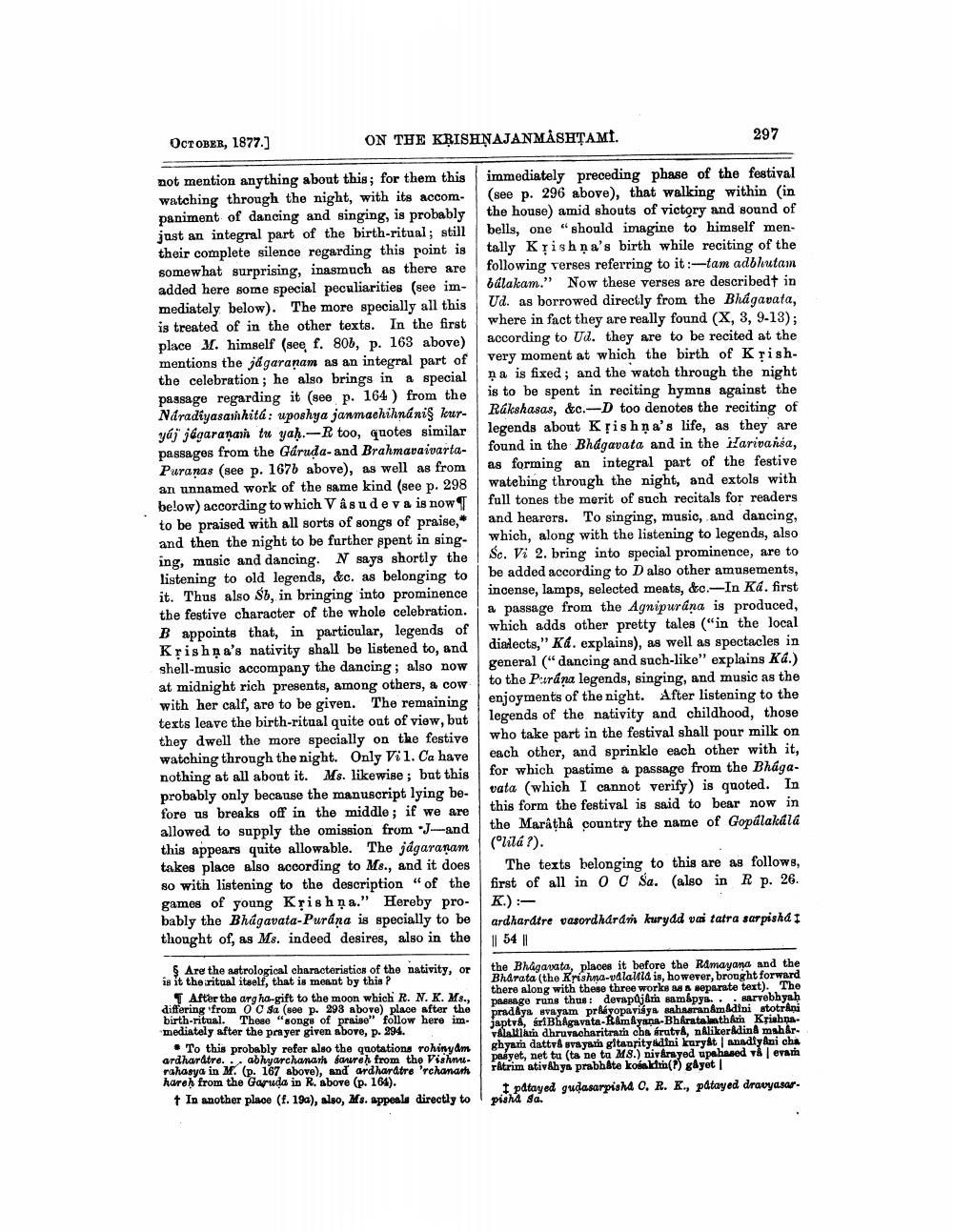________________
ON THE KRISHNAJANMASHTAMI
OCTOBER, 1877.]
not mention anything about this; for them this watching through the night, with its accompaniment of dancing and singing, is probably just an integral part of the birth-ritual; still their complete silence regarding this point is somewhat surprising, inasmuch as there are added here some special peculiarities (see immediately below). The more specially all this is treated of in the other texts. In the first place M. himself (see, f. 80b, p. 163 above) mentions the jägaranam as an integral part of the celebration; he also brings in a special passage regarding it (see p. 164) from the Náradiyasamhita: uposhya janmachihnániş kuryúj jégaranam tu yaḥ.-R too, quotes similar passages from the Garuda- and BrahmavaivartaPuranas (see p. 1676 above), as well as from an unnamed work of the same kind (see p. 298 below) according to which V âsudeva is now¶ to be praised with all sorts of songs of praise," and then the night to be further spent in singing, music and dancing. N says shortly the listening to old legends, &c. as belonging to it. Thus also Sb, in bringing into prominence the festive character of the whole celebration. B appoints that, in particular, legends of Krishna's nativity shall be listened to, and shell-music accompany the dancing; also now at midnight rich presents, among others, a cow with her calf, are to be given. The remaining texts leave the birth-ritual quite out of view, but they dwell the more specially on the festive watching through the night. Only Vi 1. Ca have nothing at all about it. Ms. likewise; but this probably only because the manuscript lying before us breaks off in the middle; if we are allowed to supply the omission from "J-and this appears quite allowable. The jágaranam takes place also according to Ms., and it does so with listening to the description "of the games of young Krishna." Hereby probably the Bhagavata-Purána is specially to be thought of, as Ms. indeed desires, also in the
§ Are the astrological characteristics of the nativity, or is it the ritual itself, that is meant by this ?
After the arg ha-gift to the moon which R. N. K. Ms., differing from OC sa (see p. 293 above) place after the birth-ritual. These "songs of praise" follow here immediately after the prayer given above, p. 294.
To this probably refer also the quotations rohinyám ardharâtre. abhyarchanam saureh from the Vishnurahasya in M. (p. 167 above), and ardharatre 'rchanam hareh from the Garuda in R. above (p. 164).
† In another place (f. 19a), also, Ms. appeals directly to
297
immediately preceding phase of the festival (see p. 296 above), that walking within (in the house) amid shouts of victory and sound of bells, one "should imagine to himself mentally Krishna's birth while reciting of the following verses referring to it:-tam adbhutam balakam." Now these verses are describedt in Ud. as borrowed directly from the Bhagavata, where in fact they are really found (X, 3, 9-13); according to Ud. they are to be recited at the very moment at which the birth of Krishna is fixed; and the watch through the night is to be spent in reciting hymns against the Rakshasas, &c.-D too denotes the reciting of legends about Krishna's life, as they are found in the Bhagavata and in the Harivansa, as forming an integral part of the festive watching through the night, and extols with full tones the merit of such recitals for readers and hearers. To singing, music, and dancing, which, along with the listening to legends, also Sc. Vi 2. bring into special prominence, are to be added according to D also other amusements, incense, lamps, selected meats, &c.-In Ká. first a passage from the Agnipurana is produced, which adds other pretty tales ("in the local dialects," Ká. explains), as well as spectacles in general ("dancing and such-like" explains Ká.) to the Purana legends, singing, and music as the enjoyments of the night. After listening to the legends of the nativity and childhood, those who take part in the festival shall pour milk on each other, and sprinkle each other with it, for which pastime a passage from the Bhagavata (which I cannot verify) is quoted. In this form the festival is said to bear now in the Marâthâ country the name of Gopalakalá (á).
The texts belonging to this are as follows, first of all in 0 C Sa. (also in R p. 26. K.):
ardhardtre vasordhárám kuryád vai tatra sarpisha I || 54 ||
the Bhagavata, places it before the Ramayana and the Bharata (the Krishna-valalla is, however, brought forward there along with these three works as a separate text). The passage runs thus: devapujám samapya.. sarvebhyah pradaya svayam prayopavisya sahasranamadini stotrâni japtva, riBhagavata-Ramayana-Bharatalatham Krishna. valallam dhruvacharitraṁ cha árutvå, nålikerådina maharghyam dattvå svayam gitanrityadini kuryst | anadlyani cha pasyet, net tu (ta ne tu M8.) nivårayed upahased vå❘ evam ratrim ativahya prabhate koiakim(?) gâyet |
I patayed gudasarpisha C. R. K., påtayed dravyasarpisha sa.




